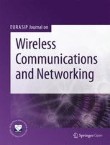EURASIP Journal on Wireless Communications and Networking welcomes submissions to the special issue on Optimization methods for Key Enabling Technologies: 5G, IoT and Big Data.
Nowadays, among others the key enabling technologies of the future and current information society include fifth generation (5G), Internet of Things (IoT), and Big Data. The 5G Radio Access technology will be a key component of the Networked Society. 5G will support massive numbers of connected devices and meet the real-time, high reliability communication needs of mission-critical applications. Internet of Things (IoT) is the new communications paradigm that will expand the current Internet and enable communication through machine to machine (M2M). Big data represents the collection of data sets characterized by high volume, velocity and variety. Due to the above traditional data processing techniques are difficult to use for value extraction.
Optimization methods are applied widely to several problems to wireless communications and information processing in general. These, among others, include convex optimization, heuristic methods, evolutionary algorithms (EAs), machine learning methods, and artificial neural networks (ANNs). The use of all of the above has an increasing impact to key enabling technologies. Additionally, hybrid combinations of Artificial Intelligence (AI) techniques and other optimization methods are also emerging.
Potential topics include but are not limited to:
- Antenna design for 5G/IoT
- Network planning for 5G
- Massive MIMO
- Spectrum usage and allocation for 5G
- Green 5G networks
- Cognitive Radio Networks for IoT/5G
- Machine-to-machine (M2M) communication
- IoT Network planning
- Route searching in IoT
- IoT Data collection strategies
- RFID networks
- Cloud computing and big data
- Telecommunication systems and big data
- Sensor networks and big data
- Big data applications in smart city
Submission Instructions
Before submitting your manuscript, please ensure you have carefully read the submission guidelines for EURASIP Journal on Wireless Communications and Networking. The complete manuscript should be submitted through the EURASIP Journal on Wireless Communications and Networking submission system. To ensure that you submit to the correct speical issue please select the appropriate special issue in the drop-down menu upon submission. In addition, indicate within your cover letter that you wish your manuscript to be considered as part of the special issue on Optimization methods for Key Enabling Technologies: 5G, IoT and Big Data. All submissions will undergo rigorous peer review and accepted articles will be published within the journal as a collection.
Deadline for submissions: 15 February 2018
Lead Guest Editor
Sotirios K. Goudos, Aristotle University of Thessaloniki, Greece
Guest Editors
George K. Karagiannidis, Aristotle University of Thessaloniki, Greece
Wout Joseph, Ghent University, Belgium
Submissions will also benefit from the usual advantages of open access publication:
- Rapid publication: Online submission, electronic peer review and production make the process of publishing your article simple and efficient
- High visibility and international readership in your field: Open access publication ensures high visibility and maximum exposure for your work - anyone with online access can read your article
- No space constraints: Publishing online means unlimited space for figures, extensive data and video footage
- Authors retain copyright, licensing the article under a Creative Commons license: articles can be freely redistributed and reused as long as the article is correctly attributed
For editorial enquiries please contact amorliza.miciano@springernature.com.
Sign up for article alerts to keep updated on articles published in EURASIP Journal on Wireless Communications and Networking - including articles published in this special issue!
